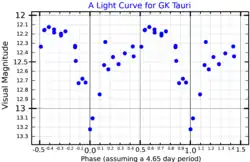| Observation data Epoch J2000 Equinox J2000 | |
|---|---|
| Constellation | Taurus |
| GK Tauri | |
| Right ascension | 04h 33m 34.5627s[2] |
| Declination | +24° 21′ 05.8545″[2] |
| Apparent magnitude (V) | 15.10 |
| GI Tauri | |
| Right ascension | 04h 33m 34.0609s[3] |
| Declination | +24° 21′ 17.0674″[3] |
| Characteristics | |
| GK Tauri | |
| Evolutionary stage | pre-main-sequence star |
| Spectral type | K7[4] |
| Apparent magnitude (G) | 11.990[2] |
| Variable type | T Tau |
| GI Tauri | |
| Apparent magnitude (G) | 12.608[3] |
| Astrometry | |
| GK Tauri | |
| Proper motion (μ) | RA: 7.46±0.02 mas/yr[2] Dec.: −20.510±0.017 mas/yr[2] |
| Parallax (π) | 7.7433 ± 0.0185 mas[2] |
| Distance | 421 ± 1 ly (129.1 ± 0.3 pc) |
| GI Tauri | |
| Proper motion (μ) | RA: 5.76±0.02 mas/yr[3] Dec.: −20.642±0.019 mas/yr[3] |
| Parallax (π) | 7.7258 ± 0.0198 mas[3] |
| Distance | 422 ± 1 ly (129.4 ± 0.3 pc) |
| Position (relative to GK Tauri)[5] | |
| Component | GI Tauri |
| Angular distance | 13.15797±0.00005″ |
| Position angle | 328.4399±0.0002° |
| Projected separation | 1700 AU |
| Details[5] | |
| GK Tauri | |
| Mass | 0.79±0.07 M☉ |
| Luminosity | 0.80[6] L☉ |
| Temperature | 4007[6] K |
| Age | 2±1 Myr |
| GI Tauri | |
| Mass | 0.53+0.09 −0.11 M☉ |
| Luminosity | 0.49[6] L☉ |
| Temperature | 3792[6] K |
| Age | 2±1 Myr |
| Other designations | |
| GK Tauri: Gaia EDR3 147790206908395776, 2MASS J04333456+2421058, GSC 01829-00040 | |
| GI Tauri: Gaia EDR3 147790000749072768, 2MASS J04333405+2421170, GSC 01829-00082 | |
| Database references | |
| SIMBAD | data |
GK Tauri is a young T Tauri-type pre-main sequence star in the constellation of Taurus about 421 light years away, belonging to the Taurus Molecular Cloud.
System
The stars GK Tauri and GI Tauri form a wide binary system, with the projected separation between components being 1700 AU. The secondary component's orbit is not very eccentric, with a periastron of at least 890 AU.[5]
GK Tauri was originally believed to have a close stellar companion WDS J04336+2421Ab.[7] However, it was found to be an unrelated background star according to Gaia data.[8]
Properties
Both members of the binary system are medium-mass objects still contracting towards the main sequence and accreting mass, with the primary GK Tauri being close to entering the main sequence.[4][5]
Protoplanetary system
Both stars are surrounded by compact protoplanetary disks, although the reason for the small disk sizes is not clear.[5] GK Tauri's spectrum indicates a possible gap in the protoplanetary disk and a planet orbiting within the gap, with a semimajor axis of 2.4+1.5
−1.0 AU.[4]
| Companion (in order from star) |
Mass | Semimajor axis (AU) |
Orbital period (days) |
Eccentricity | Inclination | Radius |
|---|---|---|---|---|---|---|
| protoplanetary disk | 0–19 AU | 40.2+5.9 −6.2° |
— | |||
| Companion (in order from star) |
Mass | Semimajor axis (AU) |
Orbital period (days) |
Eccentricity | Inclination | Radius |
|---|---|---|---|---|---|---|
| protoplanetary disk | 0–25 AU | 43.8±1.1° | — | |||
References
- ↑ Bouvier, J.; Cabrit, S.; Fernandez, M.; Martin, E. L.; Matthews, J. M. (May 1993). "COYOTES I : the photometric variability and rotational evolution of T Tauri stars". Astronomy and Astrophysics. 272: 176–206. Bibcode:1993A&A...272..176B. Retrieved 31 March 2022.
- 1 2 3 4 5 6 Brown, A. G. A.; et al. (Gaia collaboration) (2021). "Gaia Early Data Release 3: Summary of the contents and survey properties". Astronomy & Astrophysics. 649: A1. arXiv:2012.01533. Bibcode:2021A&A...649A...1G. doi:10.1051/0004-6361/202039657. S2CID 227254300. (Erratum: doi:10.1051/0004-6361/202039657e). Gaia EDR3 record for this source at VizieR.
- 1 2 3 4 5 6 Brown, A. G. A.; et al. (Gaia collaboration) (2021). "Gaia Early Data Release 3: Summary of the contents and survey properties". Astronomy & Astrophysics. 649: A1. arXiv:2012.01533. Bibcode:2021A&A...649A...1G. doi:10.1051/0004-6361/202039657. S2CID 227254300. (Erratum: doi:10.1051/0004-6361/202039657e). Gaia EDR3 record for this source at VizieR.
- 1 2 3 Marsh, Kenneth A.; Mahoney, Michael J. (1993), "Do the Spectral Energy Distributions of GK Tauri and HK Tauri Indicate the Presence of Planetary Companions?", The Astrophysical Journal, 405: L71, Bibcode:1993ApJ...405L..71M, doi:10.1086/186768
- 1 2 3 4 5 6 7 Pearce, Logan A.; Kraus, Adam L.; Dupuy, Trent J.; Mann, Andrew W.; Newton, Elisabeth R.; Tofflemire, Benjamin M.; Vanderburg, Andrew (2020), "Orbital Parameter Determination for Wide Stellar Binary Systems in the Age of Gaia", The Astrophysical Journal, 894 (2): 115, arXiv:2003.11106, Bibcode:2020ApJ...894..115P, doi:10.3847/1538-4357/ab8389, S2CID 215547945
- 1 2 3 4 Braun, Teresa A. M.; Yen, Hsi-Wei; Koch, Patrick M.; Manara, Carlo F.; Miotello, Anna; Testi, Leonardo (2021), "Dynamical Stellar Masses of Pre-main-sequence Stars in Lupus and Taurus Obtained with ALMA Surveys in Comparison with Stellar Evolutionary Models", The Astrophysical Journal, 908 (1): 46, arXiv:2012.07441, Bibcode:2021ApJ...908...46B, doi:10.3847/1538-4357/abd24f, S2CID 229156020
- ↑ "V* GK Tau". SIMBAD. Centre de données astronomiques de Strasbourg. Retrieved 18 June 2021.
- ↑ Brown, A. G. A.; et al. (Gaia collaboration) (2021). "Gaia Early Data Release 3: Summary of the contents and survey properties". Astronomy & Astrophysics. 649: A1. arXiv:2012.01533. Bibcode:2021A&A...649A...1G. doi:10.1051/0004-6361/202039657. S2CID 227254300. (Erratum: doi:10.1051/0004-6361/202039657e). Gaia EDR3 record for this source at VizieR.
